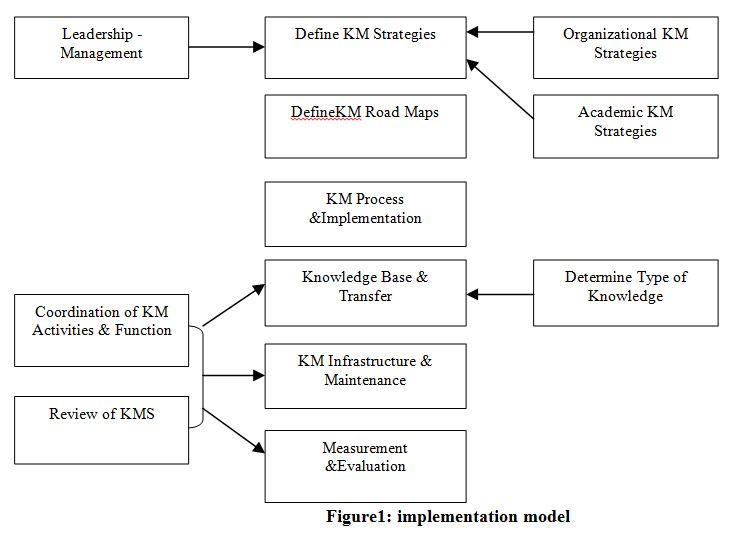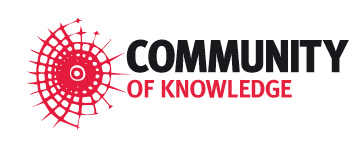Beiträge
Themengruppen
Recherche
Service
- Was ist Wissensmangement?
- Open Journal of Knowledge Management
- Artikel-Guidelines
- Newsletter
- Kalender
- Wissensmanagement-Anbieter
- Partner
- Mediadaten
Community
Sponsoren


- Hasty planning and command and to desire to extract the knowledge of experts.
- Sheer care on expository aspect of design and sacrificing accuracy for speed.
- Lack of primary study and evaluating knowledge requirements.
- Outsourcing justify irreversible renal extraction process to consultants outside the organization and Disclaimer.
- Lack of proficiency and familiarity of advisors.
- Lack of employer and advisor's care to necessity of make culture and planning in order to making physical and spiritual incentives for experts.
- Mere reliance on a very inefficient and display software to display in bringing the so-called sciences extracted.
- Designating a too little time in order to extracting skillful and experienced experts.
- Lack of stress on educating particular courses of knowledge management to experts .
- Releasing the extractions after interviews and lack of proper evaluating for completing, editing and filtering the experts.
- Lack of predicting of strategies in order to accretion of practical knowledge and creating collective knowledge.
- Lack of planning for participating before, during and after the interviews with experts.
- The shortage of human relations in organizations which causes increase of knowledge.
- Lack of proper relations between knowledge management and organizational guidelines.
- Non-clearance of knowledge and knowledge management value and inaccurate assessment of knowledge assistant which can be given to the organization.
- Lack of complete value in knowledge management practices.
- Oral skills problems in organization .
- Time destruction, necessity of heavy work and high expenses .
- Imposing extra work from knowledge management .
- Limitation in knowledge based systems technology .
- Problems of data extraction from the text.
- Increase over information.
- Coding difficulty tacit knowledge.
- Necessity of powerful culture for creating observation justification.
- Possibility of sending incorrect message from knowledge staff and information manager.
- Personal effort to perceive knowledge with expecting reward.
- Scare of criticism and be charged from management and other chairman.
- Lack of respect to the other fields.
- If lack of respect,trust and shared goals,efforts to reverse.
- Extra works which imposed to other parts of staff.
- Distaste to joint information.
- Knowledge is power source, advantage, reward and penalty.
- Challenge among professionals.
- Sense of worth and dignity due to skills.
- Assure employees to declaring creative thoughts without fear of interested critics.
- Encourage the employees to have critical viewpoints to accepted procedures and ideas about organization products and strategies.
- Making epistemology knowledge .
- Promotion of meritocracy .
- Designating part of a time to some people in order to do their favorite activities.
- Encourage to relaxation and recreation in desirable workplace.[5]
- Knowledge of consulting field
- Experience
- Professional knowledge of consultant
- Know-how and Experience
- Time for research and investigation
- Knowledge
- Quality of consulting Service
- Control of service Quality
- Ability of listening, surveying, and analyzing
- Capability
- Company reputation
- Good public relation
- Feeling
- Sense of humor
- Mastering of public Relation
- Innovation capability
- The forming and establishing of any knowledge management project is much dependent on top management support.
- To form a learning organization is highly dependent on sharing for each member to exchange his/her knowledge or experience with others. As a consequence the knowledge management implementation leads to increase competitiveness.
- The organization status physiological conditions must be considered for implementing knowledge management. Other management technologies like ERP and SCM are more concentrated in matching up with the flow within the organization with less considering the physiological factor.
Design & the Implementation of Knowledge Management System
Case study: Saveh rolling & profile Mills company
21. Februar 2011 von Yasaman Farashahian, Amin AbbasiBusiness enterprises typically are valued at the net tangible assets recorded on their books. When the market value of a firm succeeds its book value, conventional stock market theory regards the premium as the market’s assessment of intangible assets or intellectual capital of the firm. Svieby classified intellectual capital into three categories: employee competence, internal structure and external structure. The managing and measuring of intellectual capital are widely discussed in commercial applications. The implementation of key factors in intangible assets using indicators in day-to-day operations highlights the company’s value in creating processes. Many other firms apply similar frameworks in managing their intellectual capital, for example: Exxon Chemical’s, “Learning Forums”; World Bank’s, “Communities of Practice”; Toyota’s, “Alignment Rooms”; Ryder Trucks’, “Knowledge Center”; Allied Signal’s, “Mental Model Learn”; and Scott Paper’s “Real Bottom-Line Customer Service”. The purpose of this paper is to explore how an organization can adopt the concept of knowledge management and subsequently measure the intellectual capital - specifically in our company.
1. Introduction
Knowledge management is the practice of harnessing and exploiting intellectual capital in order to gain competitive advantage and customer commitment through efficiency, innovation and effective decision-making. Both the ideas of knowledge worker (Drucker, 1993) and expert labor think that knowledge management is important to any entity.
The knowledge management system is the framework of an integration of organizational elements in organizational culture, organizational information technology infrastructure and the organization’s store of individual and collective experiences, learning, insights, values, etc. Members can effectively accomplish organizational goals through knowledge management processes and procedures .A firm that effectively manages knowledge is likely to be considered a learning organization (Mellander, 2001). Knowledge dissemination and responsiveness to knowledge are cited repeatedly as the most effective way to a competitive advantage While the need for effective managing of knowledge is accepted, much of the literature continues to explore measurement and its effect on outcomes. [1]
2. KMS (knowledge management strategies) conceptual model in industries:
There are two types of knowledge involved in industries settings: academic knowledge and organizational knowledge. Academic knowledge is the primary purpose of universities and colleges. Organizational knowledge refers to knowledge of the overall business of an institution: its strength and weaknesses, the markets it serves, and the factors critical to organizational success. This paper suggests strategies for the formation of KM in an academic knowledge framework and organizational knowledge framework. Each dimension is depicted further in the following sections. It is believed that knowledge management can be used to support Company, which in turn supports teaching and learning [1]
2.1. Academic Knowledge Framework
Huang (1998) suggested four major processes to form a culture of knowledge sharing and collaboration. They are: (1) making knowledge visible, (2) increasing knowledge intensity, (3) building knowledge infrastructure, and (4) developing a knowledge culture. From an academic knowledge perspective, the learning community should start at the individual level, create departmental knowledge, create domains of knowledge across departments that share academic interests or disciplines, create institutional knowledge networks and networks with other institutions and corporations [2]. This research presents three strategies to establish knowledge ecologies within the academic framework: individual strategy, institutional strategy and network strategy.
2.2. Organizational Knowledge Framework
The most generally recognized four organizational knowledge management strategies are culture, leadership, technology, and measurement (The American Productivity and Quality Center and Arthur Andersen Consulting, 1997). As suggested by (Coukos-Semmel ,2003), examples of culture strategies in industry include staff development and training, communities of practice, and promotion of learning organizations. KM leadership strategies in industries include KM strategic planning in alignment with mission/vision, hiring knowledgeable employees, and evaluating employees for knowledgeable contribution. Company is responsible for providing infrastructure of tools, systems (intranets, web pages, electronic repositories, and data base, etc.), platforms, and automated solutions that centralized the development, application, and distribution of organizational knowledge. Measurement strategies may include benchmarking against other industries, allocating resources toward efforts that measurably increase the knowledge base, and linking and accessing impact of KM to the strategic plan.
Many KM application experts recommend the multi-perspective modeling approach. Models have been used previously from business management, such as SWOT (Strengths, Weaknesses, Opportunities, and Threats) analysis, balanced scorecards and benchmarking as good sources of techniques. [6]
3. Despite the issues is better known at the end of this stage of the process knowledge management course,we review the main factors of knowledge management projects fail. The main reasons are as follows: [3]
3.1. Obstacles in making knowledge management in organizations:
3.2. Obstacles in making knowledge management according to Davenport's viewpoint: [7]
A-Organizational viewpoint:
B-Knowledge committee and members' viewpoint:
C-Personal viewpoint:
3.3. Preventing obstacles, knowledge management usage and creation new knowledge:
4.Case Background
Saveh rolling and Profile Mills Company first started its operation in 1354 (1975) to produce various types of pipes and steel profiles with the production capacity of 50000 tons a year .In order to fulfill market development strategy and increasing the variety of products and entering exporting markets the management of this company has started its precise investment planning to promote the quality and the quantity of products. Currently we are producing 2000000 tons of different kinds of steel products in various sizes which has been regarded the outcome of this effort and precise management planning.
4.1. Knowledge management application framework in Saveh rolling and profile Mills company:
Leaders of our company recognized the need for organizational change to reposition strategically in the competitive industry.
Organization culture can inhibit or enhance organizational change efforts in knowledge management initiatives. Proper procedures are taken to ensure the concept of KM is correctly understood and thus creates a culture of sharing using organization-wide vocabulary. An outside KM specialty team is brought in as mediator for KM implementation. To ensure successful implementation of KMS, the Institute selects 50 representatives from faculty and staff of various departments to attend 14 brainstorming sessions. [4]
The design of an implementation process should focus on the user-How KM can improve a worker’s daily work? At the strategic level the organization analyzes and plans its business in terms of the knowledge it currently has and the knowledge it needs for future business processes. Road Map serves as a living document regularly updated and a framework for the monitoring of the knowledge management program. This document reflects the current state of the interrelationship between work in progress and proposed for the future and the overall milestones and aims of the program .
5.KM Implementation Model in Saveh rolling and profile Mills company[6]

Core Team is formed as center for KMS for each community, including Router for initial evaluation of knowledge proposal, Reviewer for verification, Structures for categorizing, Editor for formalizing, Category Owner for maintenance and Communicator for knowledge transfer and sharing. For each community, specific KM activities are designed for acquiring and sharing knowledge. Major categories in each community are clearly defined.
The success of KM implementation should be linked to economic performance or industry value. The performance of a COMPANY ties to rating, recruiting and financial stability.
Key success factors for Saveh rolling and profile mills company:
Conclusion
The structure of knowledge management system and its implementation benefits proposed in this paper are surely helpful for our company . Some points are reminded in the following:
References
[1] Coukos-Semmel, E. (2003). Knowledge management in research university: The processes and strategies.
[2] Paper presented at the American Educational Research Association 2003 Annual Meeting, Chicago, Illinois.
[3] Dee, J. R., Henkin, A. B., & Chen, J. H. (2000). Faculty autonomy: Perspectives from Taiwan. Higher education 40,2002
[4] Drucker, P. F. (1993). Post-Capitalist Society. New York: Harper Business.
[5] Galbreath, J. (2000). Knowledge management technology in education: An overview. Educational technology 28-33
[6] Kaplan, R. S. & Norton, D. P. (1996). Using the balanced Scorecard as a strategic management system.
[7] Davenport, T. and Glaser, J. (2002), "Just-in-Time Delivery Comes to Knowledge Management," Harvard Business Review, July, 2002, pp. 107-111.
Kommentare
Das Kommentarsystem ist zurzeit deaktiviert.
Schlagworte
Dieser Beitrag ist den folgenden Schlagworten zugeordnet

